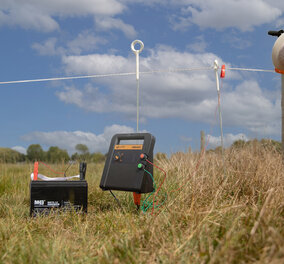Electric fence posts are crucial components in any electric fence system, laying the foundation for optimal safety. Selecting the appropriate electric fence post is essential to avoid potential issues. Here's a breakdown of various types and considerations to help you make the best choice for your situation.
Plastic Electric Fence Posts
Plastic electric fence posts have gradually replaced traditional materials due to their cost-effectiveness and advancements in manufacturing. Key factors to consider:
- Look for "glass fibre reinforced" posts for enhanced durability and resistance to mechanical stress.
- Opt for "UV-stabilised plastic" for prolonged lifespan and resilience against weathering.
- Equipped with built-in insulators, saving time and effort during installation.
- Available in various configurations to accommodate different conducting materials.
Wooden Electric Fence Posts
Although older, wooden electric fence posts remain popular, especially for permanent installations. Considerations include:
- Quality timber, preferably oak, for durability and resistance to rot and insects.
- Special electric fence insulators prevent conductivity, ensuring safety even in damp conditions.
- Typically embedded in the ground, requiring careful planning and additional costs compared to plastic posts.
- Various heights available to suit different animal sizes, ensuring adequate visibility and safety.
Fibreglass Electric Fence Posts
Fibreglass posts offer lightweight yet sturdy alternatives, ideal for mobile electric fence systems. Points to note:
- Low weight and volume coupled with stability make them suitable for various applications.
- Ensure warranty coverage, especially regarding UV resistance for prolonged outdoor use.
- Accessories like additional insulators may be needed for specific configurations.
- Heights ranging from 110 cm to 160 cm cater to different animal sizes and visibility requirements.
Steel Electric Fence Posts
Traditional and durable, steel electric fence posts are commonly used in cattle farming. Consider the following:
- Affordable yet robust, providing long-lasting performance.
- Designed for specific applications in cattle farming, featuring single insulator heads for conducting materials.
- Typically no additional strain relief required due to their sturdy construction.
- Baseline height around 105 cm, primarily used for smaller animals like sheep, pigs, and horses.
Conclusion:
Choosing the right electric fence post depends on various factors such as durability, break resistance, cost, and application diversity. Each type offers unique advantages suited to different needs, ensuring a safe and effective electric fence system.
| Fence Type | Durability | Conductivity | Maintenance | Visibility | Price Range |
| Plastic Electric Fence | High | Average | Low | High | Low-priced |
| Wooden Electric Fence | Average | High | High | Average | Low to High |
| Fibreglass Electric Fence | High | High | Low | Average | Low-priced |
| Steel Electric Fence | High | High | Low | Low |
Low to Average
|
Choose wisely to ensure the safety and effectiveness of your electric fence system. Need assistance? Our customer service team are happy to help!
Electric Fence Post FAQs
how far apart do you put electric fence posts?
Electric fence posts are typically placed 10-15 feet apart for most applications. However, for uneven terrain or corners, you may need to space them closer to maintain proper tension and alignment.
how to attach an electric fence to wooden posts?
To attach an electric fence to wooden posts, use insulated screw-in or nail-on insulators to hold the wire or tape securely. Ensure the insulators are at the correct height for the animals you are deterring and that the wire does not touch the wood to prevent grounding.
How to install an electric fence on T-posts?
To install an electric fence on T-posts, slide clip-on or snap-on insulators onto the posts at the desired height. Thread the fence wire through the insulators, making sure it remains taut and properly connected to the energiser. Adjust the insulators as needed to keep the wire level.

Fencing Expert at Electric fence Online & Farmer
Stephen grew up on a farm and now runs a smallholding of his own in Devon. With a genuine passion for animals and the countryside, he enjoys sharing his experience and offering support to others on their farming journey.





